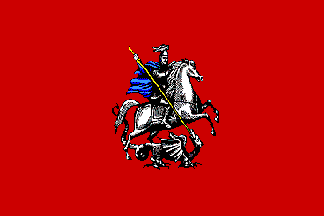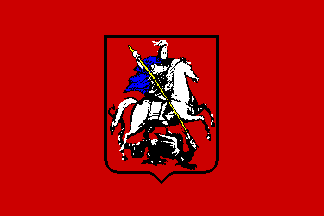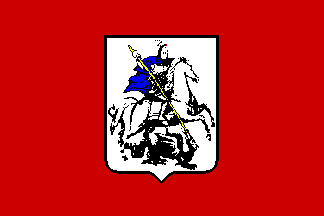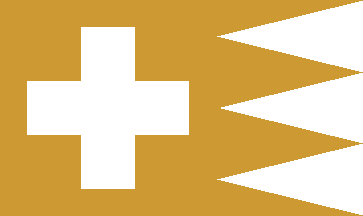
Last modified: 2013-12-05 by zoltán horváth
Keywords: moscow | moskva | mockba | dragon | knight | saint george |
Links: FOTW homepage |
search |
disclaimer and copyright |
write us |
mirrors

(Note: You need an Unicode-aware software and font to correctely view the cyrillic text on this page. See here transliteration details).
"MOCKBA" is how the russian name "Moskva" looks like
in upper case cyrillic script
— it sounds "mahsskvah".
António Martins, 25 Oct 1997
The official description is: In red field the main
element of the Moscow coat of arms (St. George) is placed.
The background is dark red with proportions 2:3,
and the length of horseman is 2/5 of flag’s length.
This flag adopted in February 1st 1995. Source:
Law on the Coat of Arms and Flag of Moscow City,
N.o 4-12.
Nicolay Khimenkov, 23 Feb 1999 and 01 Mar 1999,
and Michael Simakov, 21 and 23 Jul 1998
It’s 2:3 red with the city coat of arms’ charges
(a silver St. George riding a silver horse and dressed
with a blue coat, slaying a green dragon with a golden
spear, all lined in black) placed in the middle of the
flag but with no shield border all around. The
Moscow’s arms background is a red samnitic shield.
António Martins, 21 Oct 1997
This law states that the flag of the city of Moscow can
be used by the Mayor as a car flag for official events and
also on his official residence.
Pascal Vagnat, 13 Oct 1998
Horseman became the arms of Moscow in 1780. In
XVII cent. heraldic books the arms of Moscovia were
double-headed eagle with breast-shield
(horseman killing a dragon), not horseman alone.
Victor Lomantsov, 14 Apr 2000
There’s an interesting analogy linking Moscow’s patron saint
(St. George, as seen on the arms) and [Soviet Army General]
Georgiy Zhukov, the latter-day savior of Moscow, riding a white
horse through Red Square over the captured
Nazi regalia [in 1944]. I’m sure it
wasn’t intentional on Stalin’s part, but I’ve been told the
Muscovites certainly caught the association of images.
Joe McMillan, 11 Nov 2000
The coat of arms of the duchy of Moscow,
was red with Saint George, wearing white armor
and a blue cape, riding a white horse, holding a blue
shield, defeating the dragon.
Anton Sherwood, s.d.
The colours of Moscow coat of arms were
settled in the 18th century. Before 1730 various colours were used.
After 1730 the shield became red, the dragon — black, the cape of St.
George — yellow. Only in 1856 the cape became blue! I think colours of
the coat of arms of Moscow are based on national flag,
and not the other way around.
Victor Lomantsov, 10 Nov 1999
The rider is said to be St. George from 1730.
The dominant colors are in effect
red, blue and white.
Giuseppe Bottasini, s.d.
This one is a mirror image — the horse and knight
usually face dexter (viewer’s left hand). But it
lacks wreath, ribbon and imperial crown — or maybe
today’s coat of arms doesn’t have them…
Santiago Dotor, 17 Dec 1998
The colour (dark red) of Moscow flag is established
by the law. Chuvashian red
is purpurniy (dark red). Concerning to other russian
flags I can tell that they usually use red colour.
Nicolay Khimenkov, 02 Mar 1999
Four 1st level Russian subdivisions use dark red as a major color of its
flags: Moscow City, Mordovia,
Chuvashia and Mariy El.
António Martins, 08 Dec 2006
Some web sites (e.g. in the usually well-informed
Pascal’s AGM),
the dark red of Moscow has been changed to bright red, probably on the basis
of some other info. But the flag of the Federal City of Moscow should be dark
red — this is why emphasized the real coloration of the flag in that
photo.
Jan Zrzavy, 02 Nov 2002
In 1997.09.04 I found two variations of the city flag.
António Martins, 21 Oct 1997

This is like the normal one, but there is a black
shield lining around St.George and the dragon. This
I found by one of the doors of Belarusskaâ
subway station.
António Martins, 21 Oct 1997
It is variation of cities flag.
Michael Simakov, 23 Jul 1998

This is like the previous, but this time the shield
(black lined) has a white background, definitely
wrong. This I found in the Ŝeremethevo2 airport
Taj Mahal (Löwenbräu) restaurant, along with
the flags of India,
Germany,
Russia and
the European Union… Inside that
same restaurant, a table flag set featured all these
flags (but not Moscow’s) and also a
bavarian flag…
António Martins, 21 Oct 1997

This is something I spotted atop of one of Kremlin’s
(not “onion”-shaped) towers, in the roof of krasnoe
krylhco, near the spasskaâ clock tower: It
is a metal piece at the very top of the tower, shaped
like a flag… It has four “swallow tails” and a swiss
cross shaped hole on it. I’m not sur it this qualifies
for a “real” flag; I draw it golden because it’s made
of some kind of yellow metal.
António Martins, 25 Oct 1997